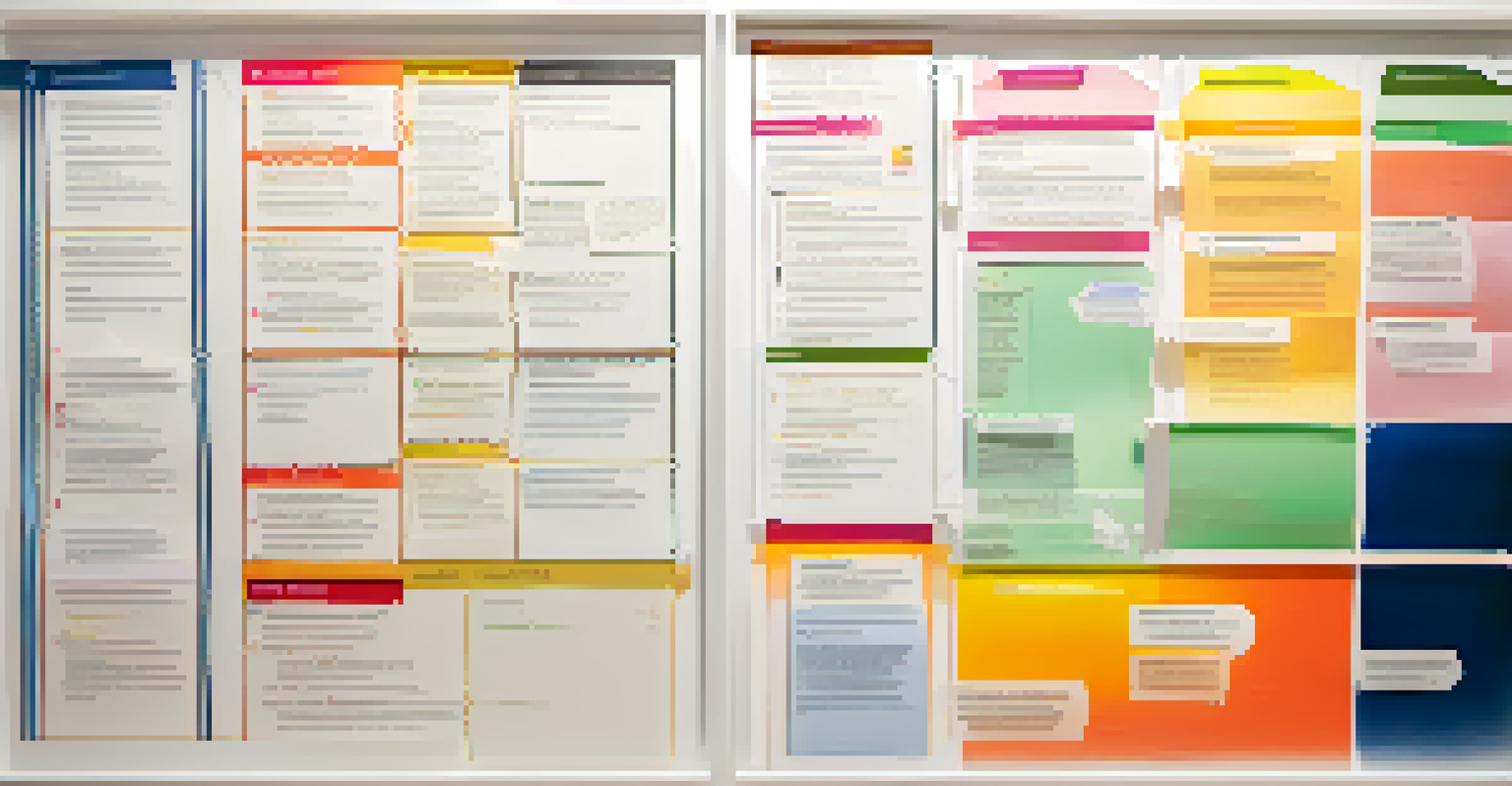Business Model Canvas vs. Traditional Business Plans

Understanding the Business Model Canvas Framework
The Business Model Canvas is a strategic management tool that visualizes a business's core components on a single page. This framework helps entrepreneurs and teams map out the key elements of their business model, such as value propositions, customer segments, and revenue streams. By using a visual representation, it allows for quick adjustments and brainstorming, making it especially useful in fast-paced environments.
Plans are nothing; planning is everything.
Imagine trying to fit all the pieces of a puzzle together without a picture to guide you. The Business Model Canvas acts like that guiding image, allowing teams to see how different parts connect and function together. This organized layout fosters creativity and collaboration, as it encourages team members to contribute ideas and identify areas for improvement.
In essence, the Business Model Canvas serves as a dynamic blueprint, promoting ongoing dialogue about the business's direction. This adaptability is one of its strongest features, making it a favorite for startups and innovative companies looking to pivot quickly in response to market feedback.
Defining Traditional Business Plans
Traditional business plans are comprehensive documents that outline a company's goals, strategies, and financial projections in detail. These plans often span several pages and are used to secure funding or guide the company over a longer term. While they provide a thorough analysis, they can also be time-consuming to create, requiring extensive research and data collection.

Think of a traditional business plan like a detailed roadmap for a long road trip. It includes all the stops, estimated travel times, and even the sights you plan to see along the way. While it's great to have this level of detail, it can sometimes become overwhelming and rigid, making it difficult to adapt to unexpected changes during the journey.
Business Model Canvas: Flexibility First
The Business Model Canvas provides a visual and adaptable framework that allows startups to quickly iterate and respond to market feedback.
While traditional business plans have their place, they might not always be the best fit for agile businesses or startups that need flexibility. The effort put into crafting a detailed plan might not be worth it if the market shifts quickly, highlighting the need for adaptability in today's fast-paced business landscape.
Key Differences Between the Two Approaches
When comparing the Business Model Canvas and traditional business plans, the most significant difference lies in their format and flexibility. The canvas provides a visual and concise overview, while traditional plans dig deep into specifics and projections. This contrast can greatly influence how teams approach their business strategy and adapt to changes.
The essence of strategy is choosing what not to do.
For instance, a startup using the Business Model Canvas can quickly pivot its strategy based on customer feedback, making necessary adjustments without the burden of a lengthy document. On the other hand, a traditional business plan might require revisiting and rewriting entire sections, slowing down the decision-making process. This can be a disadvantage in industries where speed is crucial.
Ultimately, the choice between these two approaches depends on the business's needs and stage of development. A startup may thrive with the flexibility of the canvas, while an established company might benefit from the detailed analysis of a traditional plan.
When to Use the Business Model Canvas
The Business Model Canvas shines in situations where flexibility and rapid iteration are essential. It’s particularly effective for startups, entrepreneurs, or teams launching new products or services. In these scenarios, the ability to visualize and adapt quickly can lead to better alignment and faster decision-making.
Consider a tech startup developing an app. Using the Business Model Canvas allows the team to outline key elements like customer segments and value propositions while remaining open to changes based on user feedback. This iterative process can lead to a more refined product that directly addresses market needs.
Traditional Plans: Detailed Roadmaps
Traditional business plans offer comprehensive analysis and structured guidance, making them ideal for established companies seeking funding.
In a nutshell, if you're facing uncertainty or change, the Business Model Canvas offers an agile approach that can help you navigate the complexities of starting or growing a business.
Ideal Scenarios for Traditional Business Plans
Traditional business plans are best suited for established companies seeking funding or when detailed planning is essential. For instance, if a business is looking to secure a loan or attract investors, a comprehensive plan can provide the necessary information to build trust and credibility. It showcases a well-thought-out strategy and clear financial projections.
Imagine a restaurant planning to open in a competitive area. A traditional business plan helps the owners articulate their vision, marketing strategy, and financial forecasts to potential investors. This detailed approach can be vital in a sector where stakeholders want to understand the risks and rewards involved.
In summary, if you need to present a thorough analysis or secure funding, a traditional business plan can be an invaluable tool that provides the structure and detail necessary for making informed decisions.
Combining Both Approaches for Success
While the Business Model Canvas and traditional business plans have distinct advantages, they are not mutually exclusive. In fact, many successful businesses find a way to blend both approaches, using the canvas to brainstorm and iterate while relying on the traditional plan for detailed analysis when necessary. This combination can create a comprehensive strategy that is both flexible and robust.
Think of it like cooking: you might start with a recipe (the traditional plan) but feel free to adjust ingredients based on what you have on hand or how the dish is tasting (the canvas). This flexibility allows for creativity while still adhering to a structured approach.
Combining Approaches for Success
Blending the agility of the Business Model Canvas with the detail of traditional plans can create a robust strategy for businesses of all sizes.
By leveraging the strengths of both methods, businesses can navigate the complexities of their industry with a greater chance of success. Whether you’re a startup or an established company, finding the right balance can lead to sustainable growth.
Conclusion: Choosing the Right Tool for Your Business
In conclusion, both the Business Model Canvas and traditional business plans offer unique benefits tailored to different business needs. Understanding the context in which each tool shines can help entrepreneurs and business leaders make informed decisions. The key takeaway is to assess your business’s stage and requirements to determine which approach, or combination of both, will serve you best.
As you evaluate your options, consider factors like the speed of decision-making, the level of detail required, and your industry’s demands. For dynamic environments, the canvas may lead to faster pivots, while traditional plans can provide the depth needed for investor relations.

Ultimately, the right choice is about aligning your tools with your goals. By thoughtfully selecting between the Business Model Canvas and traditional business plans, you set the stage for a successful journey in the world of business.